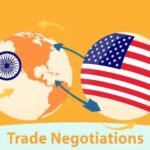India and the U.S. Engage in Active Trade Negotiations, Says Jaishankar
India and the U.S. are engaged in intense trade negotiations, focusing on defense, energy, and tech. External Affairs Minister S. Jaishankar highlighted the necessity of balancing tariffs and subsidies in any trade deal. The Trump administration appears more open to partnerships, following historical trade restrictions that influenced India’s defense procurements. The ongoing discussions present a significant opportunity for establishing a comprehensive bilateral trade agreement.
India and the United States are currently engaged in “active and intense” trade negotiations, with an emphasis on strengthening their partnership in pivotal sectors such as defense, energy, and technology. External Affairs Minister S. Jaishankar highlighted this during an event organized by the Asia Society, asserting that a bilateral trade agreement (BTA) holds significant potential, although he refrained from speculating on the outcome of the ongoing discussions with U.S. officials.
Minister Jaishankar acknowledged the necessity of balancing tariffs and U.S. subsidies, particularly in agriculture, within any potential trade deal. He expressed confidence in Indian negotiators’ abilities to secure the most favorable agreement, noting the ongoing discussions facilitated by virtual means since Commerce Minister Piyush Goyal’s recent visit to the United States.
While emphasizing the inconclusiveness of negotiations thus far, Jaishankar conveyed that previous attempts at a limited trade deal during President Trump’s first term lacked urgency, largely due to the administration’s expectation of a second term and the subsequent chaos induced by the COVID-19 pandemic. He remarked that the current discussions are characterized by increased urgency and scale.
Jaishankar further pointed out the Trump administration’s enhanced willingness to collaborate with India on critical domains such as defense and energy. He noted that Trump’s engagement has fostered a more robust security and defense partnership, ensuring that India can access military technologies previously hindered by bureaucratic processes.
In terms of energy, Jaishankar mentioned India’s desire for a stable energy environment, indicating a clear interest on the part of the Trump administration to facilitate diverse energy flows and enhance India’s choices in this sector. He referred to the decade-long import of LNG from the U.S. as a foundation for future expansion, emphasizing the reliability of U.S. energy sources.
Discussions on critical technologies also demonstrated a shared commitment to fostering reliable supply chains and transparent partnerships. Jaishankar acknowledged, however, that the policies of the Trump administration signal a broader geopolitical transformation, indicating a departure from traditional U.S. diplomatic practices which may not favor some Asian economies historically linked to global trade benefits.
Finally, Minister Jaishankar noted that historical U.S. policies had previously limited India’s defense procurement from American sources, leading India to establish defense trade relationships with the Soviet Union and Russia. He emphasized that U.S. restrictions, initiated in 1965, significantly influenced India’s defense strategy until a policy shift began in 2006, which allowed for renewed arms trade.
The ongoing negotiations between India and the United States signify a pivotal step towards a strengthened trade partnership. With Minister Jaishankar’s insights into the complexities of tariff balancing and the historical context of U.S.-India defense relations, the discussions aim to pave the way for a beneficial bilateral trade agreement. The increased readiness of the Trump administration to engage on defense and emerging technologies presents an opportunity for mutual growth. Furthermore, this evolving geopolitical landscape underscores a paradigm shift that may alter traditional economic dynamics within Asia.
Original Source: www.hindustantimes.com








Post Comment